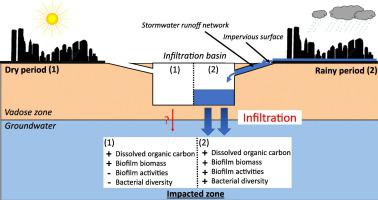Science of the Total Environment ( IF 9.8 ) Pub Date : 2020-09-22 , DOI: 10.1016/j.scitotenv.2020.142451 Yohan Lebon , Simon Navel , Maylis Moro , Jérémy Voisin , Benoit Cournoyer , Clémentine François , Laurence Volatier , Florian Mermillod-Blondin

|
Stormwater infiltration systems (SIS) have been set up to collect and infiltrate urban stormwater runoff in order to reduce flooding and to artificially recharge aquifers. Such practices produce environmental changes in shallow groundwater ecosystems like an increase in organic matter concentrations that could drive changes in structure and functions of groundwater microbial communities. Previous works suggested that SIS influence groundwater physico-chemistry during either rainy and dry period but no study has examined the impact of SIS on groundwater microorganisms during both periods. This study aimed to fill this gap by assessing SIS impacts on groundwater quality parameters in three SIS with vadose zone thickness < 3 m during two contrasting meteorological conditions (rainy/dry periods). Physicochemical (dissolved organic carbon and nutrient concentrations) and microbial variables (biomass, dehydrogenase and hydrolytic activities, and bacterial community structure) were assessed on SIS-impacted and non-SIS-impacted zones of the aquifers for the three SIS. Using clay beads incubated in the aquifer to collect microbial biofilm, we show that SIS increased microbial activities, bacterial richness and diversity in groundwater biofilms during the rainy period but not during the dry period. In contrast, the significant differences in dissolved organic carbon and nutrient concentrations, biofilm biomass and bacterial community structures (Bray-Curtis distances, relative abundances of main bacterial orders) measured between SIS-impacted and non-SIS-impacted zones of the aquifer were comparable during the two periods. These results suggest that structural indicators of biofilm like biomass were probably controlled by long-term effects of SIS on concentrations of dissolved organic matter and nutrients whereas biofilm activities and bacterial richness were temporally stimulated by stormwater runoff infiltrations during the rainy period. This decoupling between the structural and functional responses of groundwater biofilms to stormwater infiltration practices suggests that biofilms functions were highly reactive to fluxes associated with aquifer recharge events.
中文翻译:

雨水渗透系统对地下水生物膜结构和活性的影响:影响仅限于雨季吗?
已经建立了雨水渗透系统(SIS)来收集和渗透城市雨水径流,以减少洪水和人为地补给含水层。这种做法在浅层地下水生态系统中产生了环境变化,例如有机物浓度的增加,可能导致地下水微生物群落的结构和功能发生变化。先前的工作表明,SIS在下雨和干旱时期都会影响地下水的物理化学,但尚无研究检查SIS在这两个时期对地下水微生物的影响。这项研究旨在通过在两个对比的气象条件下(雨水/干旱时期)评估渗流层厚度<3 m的三个SIS对SIS对地下水质量参数的影响来填补这一空白。在三个SIS的SIS区域和非SIS区域中,评估了其物理化学性质(溶解的有机碳和营养物的浓度)和微生物变量(生物质,脱氢酶和水解活性以及细菌群落结构)。使用在含水层中孵育的粘土珠子收集微生物生物膜,我们显示出SIS在雨季而不是干旱期间增加了地下水生物膜中的微生物活性,细菌丰富性和多样性。相比之下,在含水层中,SIS影响区和非SIS影响区测得的溶解有机碳和养分浓度,生物膜生物量和细菌群落结构(Bray-Curtis距离,主要细菌阶数的相对丰度)的显着差异是可比较的在两个时期。这些结果表明,生物膜等生物膜的结构指标可能受SIS对溶解性有机物和营养物浓度的长期影响所控制,而雨季径流入渗在时间上刺激了生物膜活性和细菌富集。地下水生物膜对雨水渗透行为的结构和功能响应之间的这种脱钩表明,生物膜的功能对与含水层补给事件相关的通量具有高反应性。


























 京公网安备 11010802027423号
京公网安备 11010802027423号